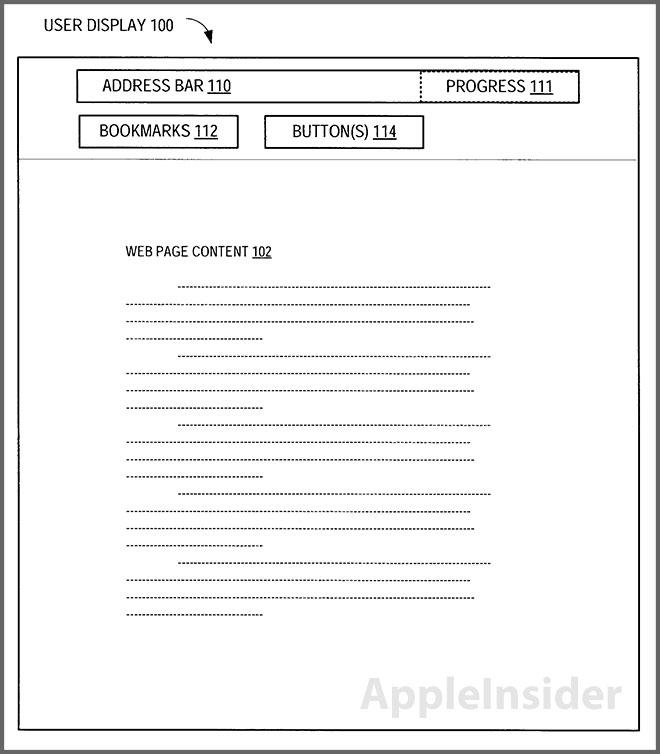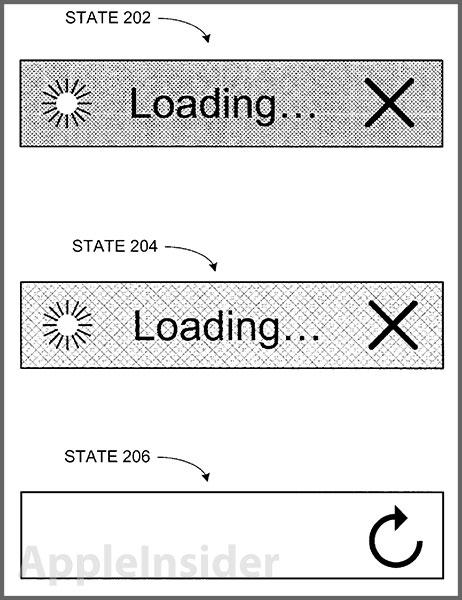The U.S. Patent and Trademark Office on Tuesday granted Apple a patent for a web browser user interface asset that monitors download, rendering and output to display a more accurate representation of the classic data progress bar.
Apple's U.S. Patent No. 8,375,319 for "Progress indicator for loading dynamically-sized contents" describes an invention that appears to be in use with the company's latest Safari web browser.
The system is a simple solution to the sometimes frustrating user experience of having a progress bar display incorrect downloaded data. Apple notes that some browsers may be set to show seemingly arbitrary visual cues instead of an accurate assessment of what was actually downloaded and ready for viewing.
From the patent summary:
However, one of the problems with progress indicators on web browsers is that they fail to accurately reflect the true progress made towards downloading web content. In other words, the progress bar on many traditional web browsers is arbitrary— it is designed to give the user the perception that progress is being made to appease the user's desire for fast downloads.
An example of a faulty interface could be the browser progress bar jumping to five or ten percent immediately after a user clicks a webpage's link. Further, a user may be shown that a specific page is 70 percent loaded, though the browser window remains blank.
In Apple's patent, a browser first displays a progress bar when it receives a request for content. From there, it monitors download and rendering progress until a usable portion of the page can be displayed onscreen. In this adaptation, the progress bar is used a cue for the user to return attention to the content viewing area when the web page has been completely downloaded.
Important to the property is the demarcation of certain status points that are directly correlated to measured content download and display changes. For example, the patent covers at least three instances when a "noteworthy" change has taken place: when a user clicks on a link or enters a URL; when usable content has been sufficiently downloaded and can be partly rendered; and when the content has completely loaded. Through the steps, unique visual cues are displayed on screen for each status point, such as the text "Loading…" in light-colored font with a dark background.
Other embodiments include automated audio or voice alerts that can notify a user when a page or content has been completely downloaded and is ready for viewing.
While Apple's patent, first filed for in June of 2009, may not be as relevant to many users with the advent of high-speed internet, the system can still be used for other purposes, such as streaming high-definition media.
Apple credits Kevin Decker, Timothy G. Hatcher and Michael P. Thole as the patent's inventors.
 Mikey Campbell
Mikey Campbell








-m.jpg)






 Wesley Hilliard
Wesley Hilliard
 Oliver Haslam
Oliver Haslam
 Christine McKee
Christine McKee
 Amber Neely
Amber Neely
 Andrew Orr
Andrew Orr

 Sponsored Content
Sponsored Content









5 Comments
i wish Apple would patented the i dea of the web page not "bouncing" around when the web page is being built up... i hate it when i go to touch a location on the iPad, while the web page is being built, and it is not where i want to go/chose... i have to wait for the spinning progress icon to stop before selecting "where to go".
was this worth the filing and attorney's fees?
I hope they add this to Final Cut Pro. An export goes from 0% to ~60% in an hour on a big export, and from ~61% to done in about five minutes.
i wish Apple would patented the i dea of the web page not "bouncing" around when the web page is being built up... i hate it when i go to touch a location on the iPad, while the web page is being built, and it is not where i want to go/chose... i have to wait for the spinning progress icon to stop before selecting "where to go".
Agree. And most annoying when you accidently hit an ad instead of the intended area.
If the page is loading and you see the thing you want to click, just click the X at the end of the URL bar and it'll stop loading and bouncing around.